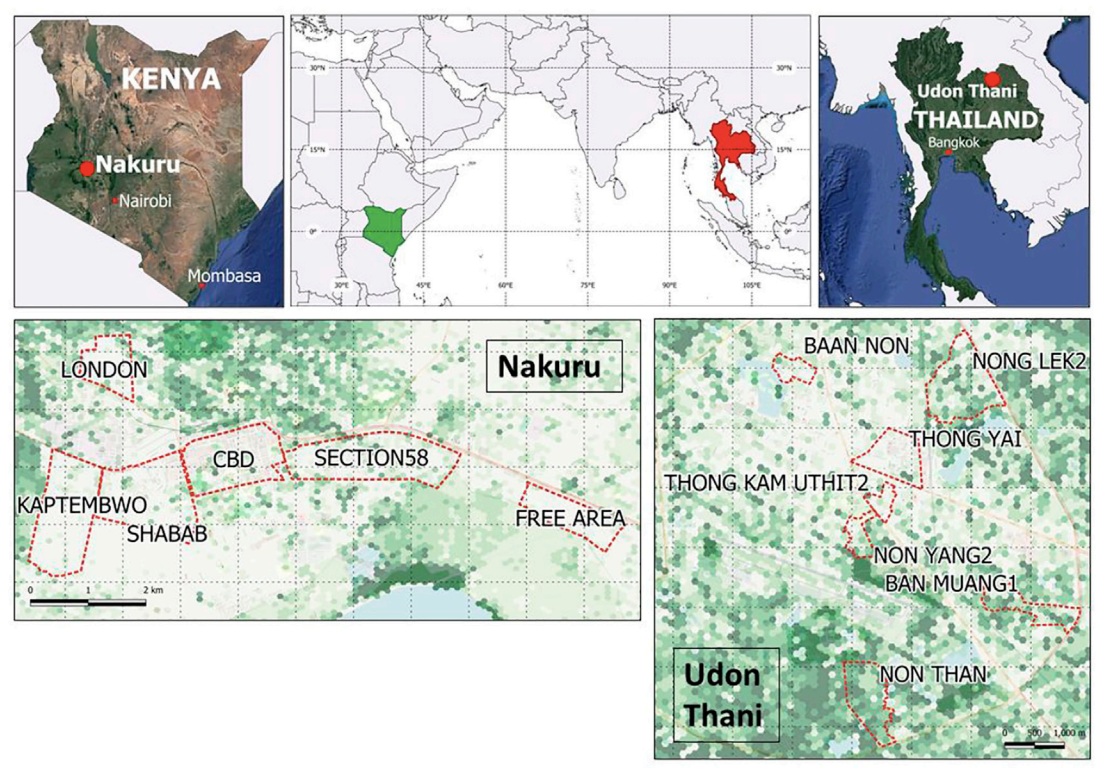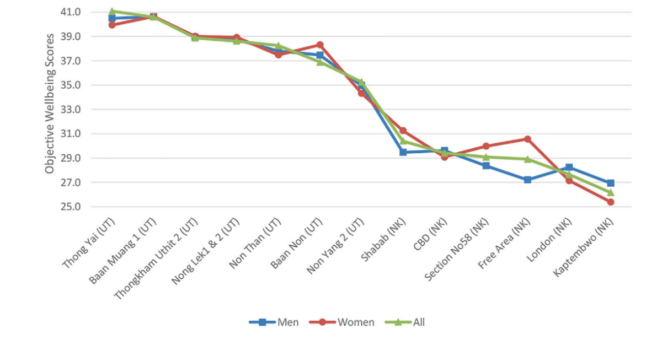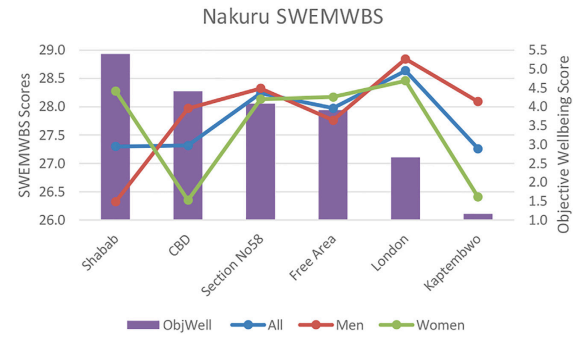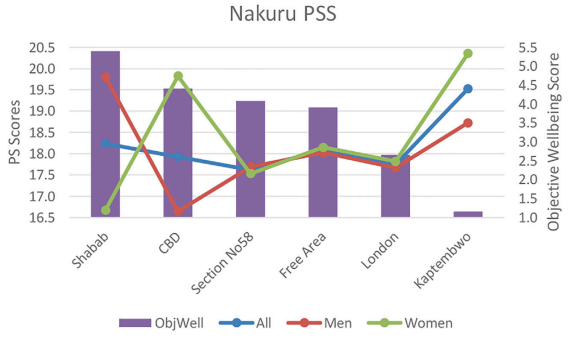Assessing Inequalities in Wellbeing at a Neighbourhood Scale in Nakuru, Kenya and Udon Thani, Thailand

This case study is part of the SEI Urban Toolbox for Liveable Cities which has been developed by the SEI Initiative on City Health and Wellbeing. The Urban Toolbox is a collection of tools, developed within SEI or in coordination with SEI, aimed at supporting planning and decision-making for improving the health, well-being and resilience of city residents and urban systems more broadly. It demonstrates how wellbeing surveys can be used to explore health and wellbeing in different geographical and cultural contexts.
GO TO THESEIURBAN TOOLBOXFOR LIVEABLE CITIES HOMEPAGE
Introduction
Evidence of what is needed to deliver urban wellbeing is largely absent from the global south. This study contributes to filling this knowledge gap through a novel interdisciplinary mixed methods study undertaken in two rapidly changing, low-middle income country cities (one Thai and one Kenyan) using qualitative surveys, subjective wellbeing and stress measurements, and spatial analysis of urban infrastructure distribution.
This study explored how multiple dimensions of city developments were impacting resident’s wellbeing in Nakuru (Kenya) and Udon Thani (Thailand), through three interlinked questions:
- How are objective aspects of wellbeing (distributed according to socioeconomic and sociodemographic characteristics) related to subjective assessments of wellbeing (life satisfaction)?
- How is the relationship between subjective wellbeing mediated by the quality of urban environments?
- What are the implications for urban development to achieve equitable wellbeing improvements?
*This Urban Toolbox article is an abridged version of the original text “Assessing Inequalities in Wellbeing at a Neighbourhood Scale in Low-Middle-Income-Country Secondary Cities and Their Implications for Long-Term Livability” published in Frontiers of Sociology, 6(729453), under the CC BY 4.0 license in November 2021 © Cinderby et al. Please note that references have been removed.For more detail, full references, and to quote text please use the paper available for download on the right.
Methodology
Case study selection:
To investigate these questions in real world settings two comparable but contrasting secondary cities of the Global South were selected:
- Nakuru, located within the Great Rift Valley, is the fourth-largest city in Kenya. It has a mixture of built environments, including informal and unplanned settlements and both green and blue spaces. Rapid growth in Nakuru is putting development pressure on the public realm including greenspace.
- Udon Thani in northeast Thailand is a small city of 130,000 residents facing rapid development due to its strategic location near the Laotian border. It seeks to have a walkable urban core, invest in green transport and green infrastructure including parks and public realm spaces.
Surveys:
This study reports on the findings from two surveys: a bespoke neighbourhood survey investigating dimensions of socio-economic, environmental and wellbeing conditions; and a validated scale questionnaire exploring individual mood effects in different urban settings. All the survey tools received individual ethical approval via the relevant University of York, UK committee and participants gave informed consent. To facilitate accurate completion surveys were translated into local languages appropriate for each city.
1. The neighbourhood survey
The wellbeing survey was carried out across diverse neighbourhoods (six in Nakuru (during November 2018 dry season) and seven in Udon Thani (during December 2018 warm season)), identified in collaboration with city officials and local project partners, which represented a cross-section of local environmental, social and economic conditions ranging from central to suburban locations, including fully to partially serviced areas in terms of public utilities neighbourhood. Adults (over the age of 18) were recruited through on-street intercepts in each neighbourhood aiming for a gender balanced sample.
This survey utilized:
- Questions on the impact on respondent’s wellbeing of eleven different environmental and social factors. The impacts ranged from large (scored 1) to no impact (4) on a forced four-point Likert scale. By summing the participant’s response scores across the eleven variables, a composite indicator of objective wellbeing was created. To assess the relative affluence of the different surveyed neighborhoods the calculated mean sum of the ranked values for homeownership, employment status and job description were used.
- The Short Warwick Edinburgh Mental Wellbeing Scale (SWEMWBS), that assesses subjective wellbeing through seven questions rated on a five-point Likert scale; translated into the approporiate local language.
- The Perceived Stress Scale (PSS), which evaluates subjective levels of stress over the previous 2 weeks.
2. The urban settings survey
To assess the impact of different types of urban spaces upon mood, a young (18–30 years) gender balanced, self-reported healthy, cohort of residents were recruited. Participants undertook transect walks between a busy built public realm space (market) and a quieter greenspace (public park) via other important infrastructure (e.g. bus interchange). These start and end points were selected to maximise the contrast in terms of type of public realm space–green vs grey; busy vs quiet. Transect walks and mood surveys were undertaken in April 2019 during Udon Thani’s hot season and Nakuru’s wet season. Walks were only undertaken on dry days and in early morning to avoid high temperatures.
This survey utilized:
- The Acute Subjective Mood measured by the University of Wales Institute of Science and Technology (UWIST) Mood Adjective Checklist (MACL) to determine acute subjective mood changes between the two key locations (market and park).
- Participants’ responses to questions on accessibility (do you live within walking distance of … ) and how much time they spend in these location (how many hours do you spend in these spaces (both within and beyond walking distance)) of greenspace and built public realm spaces.
- Satellite imagery to quantify the amount of greenspace in the study locations, using the normalized difference vegetation index (NDVI).
Analysis:
One-way ANOVA and Chi2 tests were utilized in IBM SPSS Version 26 to assess the differences between variables based upon age, gender and location. Tukey and Cramer V post-hoc tests determined the significance of any emerging associations or differences. Linear regression analysis was used to assess the explanatory strength of relationships between variables. Kruskal-Wallis H test was used to assess the differences in the distribution of NDVI pixel values by neighbourhood.
Key Findings
Objective wellbeing:
- Nakuru, Kenya – our data indicates how informal and poorly implemented infrastructure has resulted in unequal access to the provision of basic services. Poor water access and quality, and solid waste pollution contribute to measurable differences in objective wellbeing impacts between planned and less affluent districts. However, across all neighborhoods people perceived the limited water access and crime incidence were undermining their wellbeing.
- Udon Thani, Thailand – overall infrastructure and socioeconomic conditions were largely un-problematic. However, despite the effects on objective wellbeing being marginal there were a greater number of differences between neighborhoods related to variations in air quality, noise pollution and traffic congestion.

Subjective wellbeing:
- Nakuru, Kenya – subjective wellbeing predominantly lay in the ‘good’ range (scores of 26–28) whilst perceived stress fell within the moderate range (scores of 14–26). Residents who make regular use of greenspace (greater than 2- h per week) show benefits to their subjective wellbeing independent of their neighborhoods conditions. This indicates the psychologically restorative benefits of greenspace can offset stress even for those living in informal settlements.
- Udon Thani, Thailand – wellbeing was “good” to “excellent” (28+) but differences between neighbourhoods were more significant. Stress ranged from “moderate” to “low” but did not vary by neighbourhood indicating additional lifestyle factors beyond local environmental conditions were becoming influential on individual mental health. In Thailand we did not find associations between wellbeing improvements and greenspace use.


Conclusions and Reflections
- Delivering basic needs infrastructure or services universally must always be the primary city development priority.
- Accessible public realm greenspace and neighbourhood greenery can offset some of the negative impacts on wellbeing of urban living even in challenging environments (socio-economic conditions), including informal settlements counteracting some income related health inequalities.
- Neighbourhood greening needs to be culturally appropriate and relevant for local communities including the urban poor.
Future studies:
The cross-sectional survey data used in this analysis represents a snapshot of conditions at a particular moment. Cities and communities are dynamic – investigating wellbeing’s relationship to changing urban environments would therefore benefit from a long-term longitudinal approach, similar to cohort studies from health sciences. Including a wider range of quantitative data with which to compare subjective wellbeing results and environmental perceptions would also provide a more robust picture of the relationship between people and cities. To consider cultural contexts, a wider definition of beneficial urban infrastructure to include natural (brown-, green-, blue-, and barren spaces) alongside built PRS (indoor and outdoor spaces), and their combinations, would be useful when looking at the interactions of urban form and wellbeing in the Global South.
Suggested Citation:
Cinderby S, Archer D, Mehta VK, Neale C, Opiyo R, Pateman RM, Muhoza C, Adelina C and Tuhkanen H (2021) Assessing Inequalities in Wellbeing at a Neighbourhood Scale in Low-Middle-Income-Country Secondary Cities and Their Implications for Long-Term Livability.Front. Sociol. 6:729453. doi: 10.3389/fsoc.2021.729453
Related resources
- Wellbeing Surveys and Tools
- MapStakes: A tool for co-creation processes
- Empowerment in WASH Index Tool
- Using EWI to inform the implementation of a WASH master plan in the municipality of Banfora, Burkina Faso
- Using EWI to strengthen gender dimensions in Asutifi North District WASH master plan, Ghana
(0) Comments
There is no content